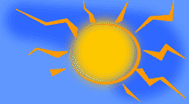 |
|
Through the Chilean Channels.
|
 |
|
Once again we're tied up at the bottom of the world. Entering
the western end of the straits of Magellan completed our circumnavigation by the roaring forties. We had a wonderful
day for the milestone as we went to visit the Grand Cascada at Bahia Wodsworth which had been our destination 4 years ago
when we were beaten back by the rising winds. At that time we decided to approach the Patagonian channels from upwind and
continued round the world to do so; a decision that was actually well worth it as we really enjoyed doing the channels with
the wind astern. But more of that later. When we left Puerto Montt we weren't certain what to expect weather wise after our
previous experiences in the south and we were very pleasantly surprised. The area of Chile north of Golfo de Penas is one
of the few places I've ever been that I want to tell everyone about as it is so good but at the same time I don't want anyone
else to know or it will become overcrowded. The weather is as good or better than Scotland with some superb hot days when
the skies are clear and you can see the distant Andes and closer snow covered volcanic peaks from every anchorage. The island
of Chiloe is densely populated along its coastline and has lots of salmon and oyster farms but still plenty of anchoring space.
Chiloe reminded us of Ireland with rolling green hills and an indented coastline of superb anchorages. It is famous in Chile
for its potatoes and ornate churches - also familiar. The churches are made entirely of wood and many of them are in bad repair
these days; but some of them are in the most splendid locations with wonderful views. Away from Chiloe the land changes completely
to uninhabited virgin forest and 100s of islands in the Chonos archipelago. These have never been cleared and it is almost
impossible to walk ashore as the dead trees lie criss-crossed on top of each other making a treacherous but very pretty moss
and flower covered aerial walkway. Most of the anchorages are short on swinging room and you end up tied to the shore as well
as anchored. We did this as often as we could to get in practice for the south when we would have to tie up in windier conditions.
It was a bit strange at first to lie calm almost under the trees with the wind whistling past overhead. Wildlife was abundant
in this area. We watched penguins stumbling up rocks to be greeted by mates braying like donkeys. They burrow into the soft
peaty soil among the roots of the big beech trees. On calm evenings we often saw otters. These were often very curious about
us and would swim all round the boat and even the dinghy if we rowed or stopped the outboard. We had 2 little ones examine
us for about 15 minutes once, sniffing loudly and growling at us. There were dolphins everywhere who loved having races with
the dinghy and soaked us with their splashing and breathing. We even had our own "rodent" type on board. We had heard stories
of stowaway water-rats but hadn't believed them until Peter had a close encounter with a furry cratur early one morning. We
were at anchor when it arrived so it must have swum out and climbed aboard. I know that no-one will believe that; I didn't
myself at first but we can come to no other conclusion. Eventually we isolated it inside a walking boot which we shook over
the side and it swam off. It could also dive and when it re-emerged its fur was bone dry. The highlight of this northern region
is undoubtedly the San Rafael glacier where we sailed right up to the face of the glacier through chunks of blue white ice.
It was spectacular and we were able to launch the dinghy and take it turns to go close to the bergs. No washing powder ad.
ever had such perfect blue whiteness. The calved ice drifts at the mercy of wind and tide; southerly winds pressing it against
the face of the glacier and across the entrance where the ebb sweeps it out in a surging mass of jostling, fizzing bergy bits
to melt in the warmer waters of Estero Elefantes. Leaving the lagoon on the very first of the ebb it was eerie to look back
and see the jagged white line of ice creeping slowly after us. We anchored in a nearby creek and even had bits of ice drifting
past and clanging into the boat. From inside the steel hull the expanding air bubbles in the ice sounded like chips deep frying. After
these northern channels we had to come out into the Pacific to get round Cabo Raper to the Golfo de Penas. The ocean was a
bit daunting after so many weeks of calm water - reefs like big black teeth fringed in white froth. The generator failed on
us in this area and while it's not life threatening we do have a 240 volt anchor windlass so fixing it was an important concern.
We were in a good anchorage and lifted the cockpit floor to remove it. Peter was able to fix it without any outside help which
was a good job as there isn't a human habitation for about 200 miles. Once again the benefits of carrying plenty of tools
and spares was obvious.
|
|
 |
|

